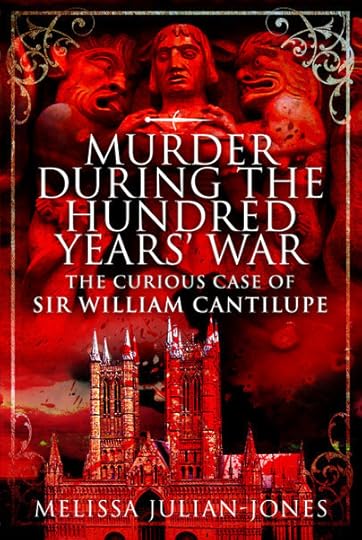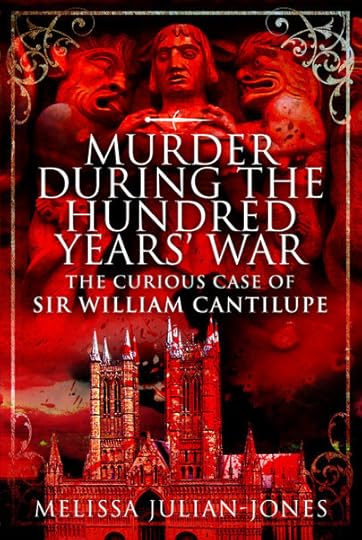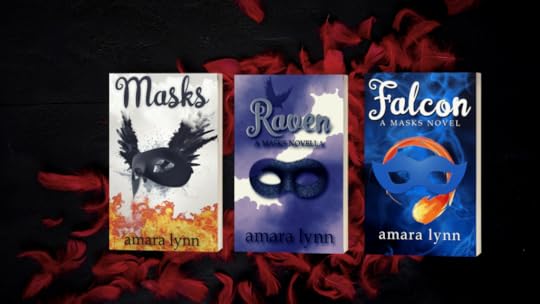C.M. Rosens's Blog, page 36
September 1, 2021
Medieval Murder ~ Justice, Law Enforcement and Cross-County Networks
 Pen & Sword Books 2020Chapter 7
Pen & Sword Books 2020Chapter 7Have you ever wondered what a medieval trial was like?
Have you ever wondered if the stereotype of the corrupt sheriff was real?
If you’ve ever seen or read historical fiction where someone is framed or is facing a trial where the elites are clearly not going to be on their side, have you wondered if real life versions of these horrors might have occurred?
This chapter goes into more detail regarding the process of the trial and the individuals involved with it, but also the connections these people had to one another. It’s not surprising that Lady Maud and Sir Ralph were acquitted (not without some reservations, since they tried to get Lady Maud indicted again, but it wasn’t possible because a previous jury had acquitted her). The main players in the trial were connected with Lady Maud’s family, the Nevilles, and to Sir Ralph Paynell.
The chapter looks at examples of sheriffs stuck between and rock and a hard place when it came to prosecuting the local elite who were of greater social standing than they were, allegations of corruption, and the lists of men involved in the trial itself.
This latter part of the chapter covers the careers and backgrounds of several individuals belonging to both the knightly and emergent merchant classes, and how their connections to the people involved in the trial continued after 1375.
Hopefully, this chapter will provide a bit more context and nuance to the medieval trial process, and illuminate the shadowy figures in the sources a little more!
Buy the book: direct from the publisher in hardback or eBook format, or from Amazon [UK / US, etc] Apple, Kobo and other eBook retailers.
If you like medieval period and are a fan of true crime, like myself, this book is a perfect blend of both. This is a fascinating look at how a medieval murder mystery was investigated.
Author Melissa Julian-Jones presents the information in a clear and crisp fashion. She details who had the opportunity and motive to kill Sir William Cantilupe (who was murdered, his body discovered in a ditch) and who had the most to gain from his death.
You will see the main suspects in the case (Cantilupe’s wife, their servants, etc.) in this murder mystery through the eyes of a dedicated investigator who uses the available evidence to come to reasonable conclusions.
I also enjoyed the author’s discussion of similar cases.
Overall, this is an original and interesting book, worthy to grace your shelves. Highly recommended.
~ GoodReads Review
August 25, 2021
Medieval Murder ~ Communal Revenge or Communal Vengeance?
 Pen & Sword Books 2020Chapter 6
Pen & Sword Books 2020Chapter 6CW: discussions of domestic abuse, abuses of power in husband/wife and master/servant relationships, sexual assault
This chapter explores the semantic differences between revenge and vengeance, and looks at whether motives can be found that fit either definition.
Revenge: to take revenge is to inflict hurt or harm on someone for an injury or wrong done to oneself.
Vengeance: punishment inflicted or retribution exacted for an injury or wrong.
Revenge is an act of passion; vengeance of justice. Injuries are revenged; crimes are avenged.
Samuel Johnson (1709-1784)
Was Sir William killed as a result of a wrong he had done to someone, a personal grudge or injury, or was he killed in an act of communal vengeance for something they deemed he ought to be punished for , but knew he might be protected by the law? These questions have not been considered previously, although the concept of a household acting together to seek revenge or vengeance is not unheard of.
In the thirteenth century, Sir William de Ardern was murdered for his tight-fistedness and his mistreatment of his servants. His steward and squire acted together, procuring the services of Richard de Bury to murder their lord, and Richard was only too happy to oblige since Sir William de Ardern had withheld Richard’s service and his pay. Richard and a number of other men ambushed and killed the lord in his own grove at Ardern, Warwickshire, and framed a local knight, Sir Richard de Insula. Sir Richard was imprisoned for a time for this crime until the truth eventually came to light, and he was released.
It’s possible Sillem didn’t know about this case when she formed her own hypothesis, but it should also be noted that in the 1930s servants still lived-in and household staff was still a common thing, so perhaps the idea of live-in servants ganging up on an unfair master and exacting vengeance (or revenge) was not a comfortable one. The more romantic love triangle was a better, more palatable theory, but also one that played into the class assumptions of the time. Schemes were for the educated elite, not the uneducated commoners.
There is then the question of what the household might be exacting revenge or vengeance for. This does not necessarily take Lady Maud out of the equation entirely, but it’s possible to take her out of the role of mastermind.
This chapter looks at medieval communities and how they self-policed, responses to domestic violence within the community deemed ‘unfair’ or ‘excessive’ and how a community might deal with that. It also considers that Lady Maud’s treatment may not have been a factor, but rather, Sir William’s treatment of the servants themselves, including of the maid, Agatha, whom it seems Lady Maud attempted to protect.
With these interpretations put forward, have you formed your own hypothesis, or changed your mind from your initial ideas? Why?
Read the full book and decide for yourself!
Buy the book: direct from the publisher in hardback or eBook format, or from Amazon [UK / US, etc] Apple, Kobo and other eBook retailers.
This is a fascinating study of a crime committed centuries ago, and the author goes through the evidence to try to determine the guilt and innocence of those accused of the crime.
William Cantilupe was found murdered, but all was not as it first appeared. The author provides a detailed examination of the evidence – sadly some of it has not been preserved and the motives are unclear, but she has researched the period thoroughly, and produces evidence of the social and economic conditions prevailing at that time. Its an interesting case, and well presented. The author does not try to persuade the reader one or way or another, nor does she jump to conclusions based on the preserved evidence, but offers all potential scenarios.
An interesting academic read, well presented.
~ 5* Amazon and NetGalley Review
August 20, 2021
#AmWriting: WiP Playlist THE DAY WE ATE GRANDAD
I’m in the ‘percolating’ stage for my current novel in progress, THE DAY WE ATE GRANDAD.
It is the third in the Pagham-on-Sea series, which are not a strict chronological series but more like the Discworld books in concept, where there is a setting that connects all the groups of stories together.
This is the third one with the same characters as THE CROWS and THIRTEENTH and is more a direct sequel to THIRTEENTH, but I have PoS books planned that are unrelated to this series, and ones that spin off the same central family as this trilogy. I guess this is the Fairwood series within the series?
Anyway, I thought this would be a fun game to try and focus my thoughts and pull the draft together…
Original Post on TwitterOk #WritingCommunity, let's play a game!
— Avery Ames (@AveryAmes) August 19, 2021
If you make a playlist for your WIP using this outline, please share it here! pic.twitter.com/QaOxjaPeA8
 Created by Avery AmesMy WIP Playlist
Created by Avery AmesMy WIP Playlist1. OPENING CREDITS: The theme tune by Gemma Cartmell would be the opening… I asked for a theme that echoes the one for THE CROWS and THIRTEENTH, but this should be more Welsh folk, and reflect the themes of grief and bereavement. Check it out:
Composed by Gemma Cartmell: contact her for commissionsDetail from the cover design by Rebecca F. Kenney
2. MC’S “I WANT” SONG: I have 3 MCs, the same as in THIRTEENTH, which makes TDWAG a direct sequel in a way THIRTEENTH is not exactly a direct sequel of THE CROWS. The problem is that at the start of this novel, none of them really know what they want. It opens at a point where they’ve had to let go of a lot of the things they thought they wanted at the end of THIRTEENTH, because life – and the consequences of their actions and decisions coming back to bite them – means things have taken a Turn.
Katy thinks the way to get what she wants is to complete the task she’s ‘born’ to do, so she leans into that, largely because she really believes that her life will be better once everyone’s dead, and she isn’t entirely wrong: KILL EVERYONE | Hollywood Undead
Wes wants the cull to end as quickly as possible so he can rebuild his life from the wreckage – he also wants to emerge from it more powerful than he was before (so he won’t be looked down on by family elders and enjoy doing nothing except what he wants to do): THE ANTHEM OF MR DARK | The Arcadian Wild
Ricky has absolutely had enough of everyone and everything, and he hasn’t gone through all this bullshit to be continuously fucked around, so he’s very insistent on his position as a god in the family, and that he wants to be the master of Fairwood, not just a lodger, which is causing some serious friction at home: KING FOR A DAY | Pierce the Veil, Kellin Quinn
3. MC’S MOST IMPORTANT RELATIONSHIP SONG: At the beginning of the book, the MCs are all strongly reliant on each other even though they are basically estranged or separated by physical/emotional distance.
Katy at the start of the book believes that self-reliance is the most important thing, because of the amount of people she’s lost and she is struggling to find herself in her new role: LOVE MYSELF | Hailee Steinfeld
Wes will always have his partners as his most important relationships and he’s also aware that, after eight years with his girlfriend and four years with his boyfriend, he’s a nightmare to be with, but he’s pretty much nothing without them: I’M NOT A SAINT | Billy Raffoul
Ricky‘s most important relationship at the start of the novel is with Fairwood, and he’s seriously messing it up, largely on purpose, because the one thing he is the master of is epic self-sabotage: ENDING | Isak Danielson
4. A SONG FOR THE SETTING: The novel takes place in an alternative contemporary U.K. with scenes in Pagham-on-Sea, East Sussex (fictional), London, possibly Basildon, and maybe somewhere else for a funeral scene. It also has a bit of Wales in there at last!? But there are also significant scenes in the Outside, where eldritch entities await, eager to enter our world… so maybe there’s a few options here…
THE TRAITOR | Atrium Carceri – The Outside
ENGLAND SCREAMS | Strange Bones – most of it (apart from the Welsh setting scenes)
THE BURNING FOREST | Enrico Pasini – Wales & related Welsh myth settings (will update when I find a Welsh song with this exact vibe, recs welcome)
5. THE VILLAIN’S SONG: In this case, the antagonistic element is the apocalyptic death cult that has sprung up, intent on taking their place as gods once the cull is complete.
1997 | Saint Motel
6. THE LOVE INTEREST OR SIDEKICK’S THEME SONG: There are three side characters of importance, who have their own POVs! Fairwood is a central one for Ricky and Katy, but there’s also Layla, whose determined normalcy and refusal to give in to the family is really important for Ricky, who needs a kick up the arse from someone who isn’t Wes. On the other side of things there’s Theo, who has joined the death cult and is absolutely villain sidekick material if he thinks the villain is hot. Which he does.
Fairwood: DEAD IS THE NEW ALIVE | Emilie Autumn
Theo: RELIGION | Isak Danielson
Layla: NEVER SURRENDER | Paul Herzog
7. A SONG FOR SOMETHING SAD/UPSETTING THAT HAPPENS TO THE MC: Honestly a lot happens that is sad/upsetting but here are three teaser songs…
Katy : MONSTER | Skillet
Wes … um. Wes has to face up to a few things. His whole existence is upsetting, to be honest. OUTRUNNING KARMA | Alec Benjamin
Ricky has to face up to what he is most afraid of, and it isn’t what he thinks it is… HOLD ON FOR YOUR LIFE | Sam Tinnesz
8. A SONG ABOUT THE MC’S DOUBTS OR FEARS: The doubts/fears of these three are fairly dramatic, but ultimately they each have to face up to the people they are, and the ones they could turn into. Grief and guilt, and the many related emotions that come with bereavement and loss, can themselves monstrous things, and this threatens to consume them in different ways until they learn to deal with it.
NIGHTMARE | Set It Off
9. A SONG FOR WHAT THE MC REALISES THEY WANT EVEN MORE THAN #2: Ultimately, they are all looking for the same thing, which is not only somewhere to belong, but to be able to belong there. What they want is to be able to be family properly, in a healthier way.
HOME | Machine Gun Kelly, X Ambassadors, Bebe Rexha
10. A SONG THAT REPRESENTS WHAT THE MC HAS LEARNED THROUGH THEIR ARC: All three of them have to face not only the person they each are, but the people who had a hand in shaping them. They confront a lot of generational trauma and realise that they are equal to the task of overcoming it. Both these songs are applicable to all three MCs.
BONES OF A RABBIT | Young Heretics
BEAUTIFUL DARKSIDE | The Classic Crime
11. A SONG ABOUT THE STORY’S OVERALL THEME:
MIDDLE FINGER | Bohnes
12. THE CLOSING CREDITS:
August 18, 2021
Medieval Murder ~ Motive: Affairs of the Heart
 Pen & Sword Books 2020Chapter 5
Pen & Sword Books 2020Chapter 5CW: discussion of domestic violence and sexual assault
This chapter explores the motives of love/lust/jealousy, not only from the perspective of Lady Maud as the wife with one or more other lovers involved in the conspiracy to murder her husband, but from the perspective of the other figures in the drama.
It looks at theories of medieval marriage, monogamy and the practice of non-monogamy and extra-marital relationships, the attitudes and norms in practice of people in this period, and takes a few different ideas into consideration, including the ‘traditional’ theory of the scheming, adulterous wife posited by Sillem in the 1930s.
The traditional approach involves a love triangle between Lady Maud, the sheriff Sir Thomas Kydale, and her husband Sir William. Other scholars have assumed the armour-bearer Richard Gyse was also the young lover of Lady Maud, and that this was his motive for slaying his lord. This is predicated on several baseless assumptions: firstly, that of attraction – we have to presuppose that both Richard and Sir Thomas were attracted to Lady Maud and in love with her – but also that both of them were heterosexual to begin with.
Supposing that this was the case, note that when Lady Maud fled to Sir Ralph’s manor after the murder, she took both Richard and her maid Agatha with her. Agatha was the only other woman in the household, and it might be that Richard was not interested in Lady Maud but in Agatha. If Agatha had also come to the notice of Sir William, she had very little agency to resist his advances. That would be an equally plausible reason for her to hand over the key to the bedchamber and for the householders to stab him multiple times. Agatha had worked with six of the household servants before, all of whom were heavily implicated as a core group of conspirators in the indictments.
We will never know! But taking into account the historical context, the dynamics of a household and all possible permutations of those dynamics, what are your theories so far?
Buy the book to get a clearer picture of the situation and form your own ideas!
Buy the book: direct from the publisher in hardback or eBook format, or from Amazon [UK / US, etc] Apple, Kobo and other eBook retailers.
I have to recommend this book. It is an interesting, thorough exploration of a crime that should appeal to true crime buffs, those who enjoy a good medieval mystery and those who want to understand more about medieval life, especially the more grisly elements.
NetGalley Review
August 11, 2021
Medieval Murder ~ The Money Motive
 Pen & Sword Books 2020Chapter 4
Pen & Sword Books 2020Chapter 4Chapter 4 is the first of the ‘Motive’ chapters. Since no motive is recorded, and the assumption of a love triangle is the basis for the traditional interpretation of the case, the middle chapters of this book look at alternative ideas, and present them for the reader to consider alongside the evidence.
In this chapter, we follow the money: or rather, we look at material loss/gain. Who stood to gain by Sir William’s death, or lost out while he was alive?
Sir William and his older brother, Sir Nicholas IV de Cantilupe, inherited directly from their grandfather, Sir Nicholas, third Baron Cantilupe. While their father, William, was well provided for by his father, he was passed over for the title and lands in favour of his children, which wasn’t an unusual move. The de Strelleys, neighbours of the Cantilupes in Lincolnshire, did the same thing. While this could be a comment on his suitability, it’s more likely to be a way of making the grandchildren more attractive as marriage prospects for family allies, and perhaps part of the betrothal negotiations.
The chapter considers the likelihood of filicide, with William senior as a shadowy figure behind the scenes, although he was never indicted nor implicated in the case.
It also looks at what his widow was able to claim as her dower – very little, as it happened, and she only pursued what was rightfully hers through her third husband, John de Bussy, who outlived her.
Sir William did, however, retain certain castles that he inherited from his brother, who had refused to return them to the Paynells after the break-up of his disastrous marriage to Katherine. Is that why Sir Ralph Paynell was involved in the case? Or did he have other reasons too?
What do you think of material loss/gain as a motive for the murder? Grab a copy to read the case for yourself and see what you think!
Buy the book: direct from the publisher in hardback or eBook format, or from Amazon [UK / US, etc] Apple, Kobo and other eBook retailers.
Curiously, the story has not previously been the subject of a book, a deficiency that I am pleased to say has been corrected by Dr Melissa Julian-Jones with this volume – warmly recommended.
Ripperologist, July 2021, No. 169 – review by Paul Begg
August 4, 2021
Medieval Murder ~ The Indicted Suspects
 Pen & Sword Books 2020Chapter 3
Pen & Sword Books 2020Chapter 3Chapter 3 of Murder During the Hundred Years’ War takes a look at all the indicted suspects in the case – there’s a helpful list at the start of the book that readers can refer to!
Nearly all of these individuals are shadowy at best, and there is next to no biographical information about them. This chapter lays out what we do know, and then looks at the roles of servants and the lives of medieval women, men and younger people of lower status more broadly. This chapter also considers other murder cases where someone of similar status was involved – other cases of wives murdering their husbands, servants killing their masters, squires/armour-bearers attacking their knights.
Who was indicted for Sir William’s murder/aiding and abetting the killing?
Lady Maud, his wifeSir Ralph Paynell, his late brother’s ex-father-in-lawRobert of Cleatham, the steward of Scotton ManorRichard Gyse, the armour-bearerRobert Cook, the butlerJohn Barneby of Beckingham, the ChamberlainAgatha Frere/Lovell, Lady Maud’s maidOther servants, whose position in the household is unclear:
John AstynWalter/William Chamberlainman (confusingly, not the chamberlain, so appears to be an occupational surname, and his first name changes in different indictments due to scribal error, Walter is probably correct)Augustine ForesterAugustine WarnerJohn HenxtemanAugustine MorpathWilliam de Hayle/HoleHenry TaskerThis chapter looks at household conspiracies, including other cases where a wife bribed her servants to murder her husband. The botched murder of Sir William Picard of Goldington, Bedfordshire, is a memorable example, in which his wife Lady Joan paid several servants to kill him as he sat in his chair by the fire one night. He was hit over the head with an axe so that he fell into the fire, but this didn’t kill him, and one of the attackers had to grab a knife from the table [a trenchard] and stabbed him through the heart.
Feuds between noble families are also discussed, with examples of nobles killing each other when disputes got out of control. In the previous century, one of the Cantilupe cadet branches bore the disgrace of a murderer in the family, when one of them was hanged for killing a member of the Goldingham family after a legal dispute.
Servants who attacked their masters for their own reasons, not because they were bribed or coerced to do the deed, are also considered. Sir William de Arden’s steward and armour-bearer were responsible for the conspiracy against him, for example, and he was murdered in a grove he possessed by a servant who had his own reasons for hating him and gladly did the deed. A local knight, Sir Richard de Insula, was framed for the crime and imprisoned, but when the conspiracy came to light he was eventually released.
Chapter 3 provides a lot of context for the following chapters, which take a look at various possible motives for the murder of Sir William Cantilupe and various ways the murder could have come about. The plausibility of the ‘traditional view’, that Lady Maud was behind it, is also given weight, but alternative theories are equally as strong considering the evidence.
Who do you think did it, and why?
Buy the book: direct from the publisher in hardback or eBook format, or from Amazon [UK / US, etc] Apple, Kobo and other eBook retailers.
This is a fascinating study of a crime committed centuries ago, and the author goes through the evidence to try to determine the guilt and innocence of those accused of the crime.
William Cantilupe was found murdered, but all was not as it first appeared. The author provides a detailed examination of the evidence – sadly some of it has not been preserved and the motives are unclear, but she has researched the period thoroughly, and produces evidence of the social and economic conditions prevailing at that time. Its an interesting case, and well presented. The author does not try to persuade the reader one or way or another, nor does she jump to conclusions based on the preserved evidence, but offers all potential scenarios.
An interesting academic read, well presented.
5* NetGalley Review
July 28, 2021
Medieval Murder ~ The Victim
 Pen & Sword Books 2020Chapter 2
Pen & Sword Books 2020Chapter 2Chapter 2 of Murder During the Hundred Years’ War introduces the victim, Sir William Cantilupe. We know nothing of his childhood and early years from a personal perspective, and so this chapter takes a broader view, putting his life in context of the events he lived through.
What did the childhood of a noble status child look like? What toys did they play with? How were they trained?What impact did the Black Death (1348-49) have on the survivors, and how might this have impacted his childhood?What about family history and the weight of familial expectations – can we uncover family dynamics that might be relevant?At some point, Sir William married Lady Maud – a Neville, of a cadet line of that powerful family, who seems to have been orphaned by or around the time of her marriage. Sir William went on campaign in France as part of the Hundred Years’ War – what happened on campaign, and how might this have shaped him? It’s impossible to know for sure, but since no motive is recorded for his murder, acknowledging all the unknowns and possibilities is important before we accept certain interpretations of the evidence! Sir William’s military career was cut short when he was arrested for the murder of his brother, Nicholas, from whom he inherited all the Cantilupe lands. He was acquitted and released from the Tower of London, and Sir Nicholas’s death was ruled to be of natural causes. Sir William disappears from the records for a few years, then turns up dead. What’s the story there?This chapter deals with medieval childhood and adolescence, the trauma of the famines and plague, family dynamics and how to uncover it, the legacy of Sir William’s grandfather (statesman, spy, knight, among other things…) and poses questions about the man himself.
The accepted motive for the murder among scholars is Sillem’s love triangle theory, but could there be more to it that that? How many other motives could there be, unexplored, which nonetheless fit with the evidence and the events we know of?
Find out more…
Workshopping A MurderWhen I teach this as a class, I invite my students to put together their own thoughts about him and back up their theories with the source material, as this is a good exercise not only in critical thinking and handling sources, but also as a demonstration of how ‘filling in the gaps’ and interpreting patchy evidence can lead to wildly different opinions and theories. It’s a good lesson in why you shouldn’t take anything as read in situations like these, and a good exercise to unpick what is fact, what is plausible, and what is the student’s own assumption. What assumptions you make in filling in gaps like this reveals the biases you hold, and it’s helpful to be self-reflective about this when you’re working with sparse details.
I also encourage students to discuss Sillem’s own perspective and context – England in the 1930s – and ask what factors could have led her to propose her love triangle theory. Similarly, what makes scholars pick this up uncritically and cite it as fact? Bear in mind that she isn’t necessarily wrong! It’s as good a motive as any. But as the weeks go on, I encourage students to think about the other equally valid motives there might be for the crime, and to present their own theories at the end of the course in a medium of their choice.
When I teach a shortened version of this course as a two-part creative writing workshop, I focus on the creative interpretation angle, and encourage all kinds of creative responses to the case as a writing prompt for any genre.
What would your biography of Sir William look like? Grab a copy of the book to play along, and/or watch out for announcements on my next short creative writing workshop!
Buy the book from Pen & Sword directly – available as hardback and eBook. You can also buy a copy from Amazon, but the hardbacks run out of stock there quickly!
If you want me to run a workshop like this for you, my fee is £50 payable via PayPal – you can commission me on Ko-Fi. Please note that I do have a full time job Mon-Fri, so workshops would have to be weekday evenings or weekends only, British time.
July 26, 2021
Author Interviews ~ C. M. Rosens (it me!!)

C. M. Rosens is my pen-name for fiction – I publish academic and nonfiction titles under my legal name.
I write contemporary Gothic Weird fiction that comes broadly under the ‘Horror’ genre, and you can find all my work on this page!
My pronouns are she/her although I’m more quoigender than anything.
C. M. Rosens is also a persona or character who appears in the Paghamverse, via the podcast and the Folklore of Pagham-on-Sea short volumes, as a member of the local History Society. CMR as a persona may end up with a character arc of their own.
Consequently, CMR is branded with author headshots and photos like this one, which were part of a professional shoot in 2009, while I post actual recent selfies and use more recent photos of myself for my academic and nonfiction publishing work. You will also see me in person leading creative workshops and/or giving talks with Romancing the Gothic now and again!
Here I am in two interviews posted to RomGothSam’s YouTube Channel. I’m available for podcasts and booktube appearances too!
July 22, 2021
Queer Superheroes: Interview with Amara Lynn

Amara Lynn has always been a quiet daydreamer. Coming up with characters and worlds since childhood, Amara eventually found an outlet in writing. Amara loves anything to do with pirates, villains and superheroes, and angels and demons.
Amara is addicted to music and gets the most inspiration from moving songs and lyrics. When not writing, Amara usually reads, listens to podcasts, watches anime, plays a video game here and there (but mostly collects them), and takes way too many cat pictures.
Amara is non-binary/enby and queer and uses they/them pronouns.
Twitter – @AmaraJLynn
Website: https://amarajlynn.com/
Amara Lynn is the author of the Masks series, and the first novel-length installment, Falcon, is coming soon! Grab the first two shorts in the series while you wait! The series follows Avari, supervillain, and his love interest/boyfriend Chayton, superhero, as they deal with demonic threats to the world.
 Author Interview
Author Interview1. Without too many spoilers, what is your favourite character arc in this series and can you represent that with songs or an aesthetic?
My favorite arc is Chayton’s. There’s a lot more exploration into his feelings and mental health that readers don’t get any insight into in the first two books. I can’t say much more about it, but it delves into how Chayton really feels, which is completely the opposite of how he acts outwardly. I’m really excited for people to read it.
I actually have a whole playlist for each of the main trio of characters. I’ll share Chayton’s since we’re talking about him: https://open.spotify.com/playlist/4hpdSYpsaGLmveuwCX3Z7s?si=25884c3afbfb43f0
The song that represents him most from the list would probably be “I Can’t Save The World If I’m Not Happy” by Eliza Grace.
And since you asked (I love making aesthetics!) here’s one to represent Chayton.

2. What rep can we expect in this book and the series as a whole?
In the latest volume, there’s a deeper dive into the main character, Avari’s, sexuality as he realizes (with the help of his annoying sidekick) that he’s demisexual.
As a whole, the series features gay, bisexual, and demisexual rep in the main three characters, as well as a queer supporting cast who will be explored more in further stories.
3. What are the main themes of the book and why did you want to explore them?
Some of the themes explored in the series, and in particular this book, are the lines between good and evil. Avari starts out the series as more of a villain, and while he sometimes thinks of himself as the hero/antihero of the story, more often than not, he still thinks he’s the bad guy, because he’s not cheerful and he often creates problems when trying to fix others (no thanks to his best friend giving him AWFUL advice haha). This book explores more of Avari’s psyche as he continues to deal with the fallout of his decisions in the first two books of the series.
I’ve always liked the villains, especially in things like old Disney movies and other cartoons, so the idea of exploring my own “bad guy” always held some appeal. I find villain motivations fascinating. Sometimes, the bad guy’s motive isn’t as bad as we’re led to believe. And when you think about it, the hero is the villain from the villain’s perspective. Anyways, I love exploring that whole dynamic in my own setting.
Get the Books:July 21, 2021
Medieval Murder ~ The Discovery of A Body 1375
 Pen & Sword Books, 2020Chapter 1
Pen & Sword Books, 2020Chapter 1In exploring Sir William’s 14thC context, this book necessarily touches upon a variety of issues that some readers may find distressing or difficult, including domestic violence and sexual assault, and, where Sir William’s brother Nicholas is concerned, negative attitudes towards and traumatic consequences of the discovery of his atypical genitalia.
The book starts off with the discovery of a knight’s body in a field at Grayingham, Lincolnshire, in 1375. The first section explains the process of what happens next: the raising of the hue, reporting to the coroner and sheriff, and the coroner’s process of examination.
Who was responsible for the body once it was found?
What did the coroner do in an age before more advanced forensics?
What were comparative crime stats in rural areas at the time?
The cause of death was fairly obvious – multiple stab wounds to the torso, Murder on the Orient Express style. Roving gangs of highwaymen could have been blamed – there is a section on such roving gangs and their social makeup, focusing on the activities of the Folvilles and the Coterels in the 1320s. Yet this was ruled out once it was discovered that Sir William’s household had closed up the manor of Scotton, where he was last seen a few months prior, and the servants had scattered. His wife, Lady Maud, was found in the house of Sir Ralph and Lady Katherine Paynell, at Caythorpe, Lincolnshire, some 40 miles away. She had been there for as long as Sir William had been missing, together with her maid Agatha and Sir William’s armour-bearer, Richard Gyse.
Scotton Manor was found to be the real scene of the crime. The description and background information on medieval manors puts this into context, and reveals the existence of a household conspiracy: there was no way he could have been murdered in the manor without everyone knowing about it.
Lady Maud’s testimony provides the details of how this was done, but she laid the blame on two people specifically, rather than on the whole household. No motive was recorded for the murder in the records.
This chapter then looks at scholarly opinion from the first interest in this case, by Rosamund Sillem in the 1930s. Sillem, writing at the height of the Golden Age of Detective Fiction and in a social context where live-in servants were still very much a norm, suggested a love triangle between Sir William, his wife, and the sheriff Thomas Kydale, and the servants were patsies, paid off by Kydale and Sir Ralph Paynell who had a grudge against the Cantilupe family. There is no evidence for this except the fact that when Lady Maud was acquitted of murder and accessory to murder, she married the sheriff.
This has been taken up largely uncritically as the explanation for the murder by scholars, who have struggled to explain Sir Ralph’s involvement until Frederick Pedersen’s investigation into the disastrous marriage between Sir Ralph’s daughter Katherine (named after her mother) and Sir William’s older brother Nicholas.
This chapter sets out the backbone of the case, and prepares to launch off into deeper explorations of the characters involved and alternative interpretations of the same evidence – including alternative motives for the crime, none of which, until now, have been considered in depth in the scholarship.
Buy the book: direct from the publisher in hardback or eBook format, or from Amazon [UK / US, etc] Apple, Kobo and other eBook retailers.
This is a fascinating study of a crime committed centuries ago, and the author goes through the evidence to try to determine the guilt and innocence of those accused of the crime.
William Cantilupe was found murdered, but all was not as it first appeared. The author provides a detailed examination of the evidence – sadly some of it has not been preserved and the motives are unclear, but she has researched the period thoroughly, and produces evidence of the social and economic conditions prevailing at that time. Its an interesting case, and well presented. The author does not try to persuade the reader one or way or another, nor does she jump to conclusions based on the preserved evidence, but offers all potential scenarios.
An interesting academic read, well presented.
Thank you to NetGalley and Pen & Sword History for allowing me access to the ARC in exchange for an honest review.
~ ARC Review on NetGalley and Amazon.co.uk



